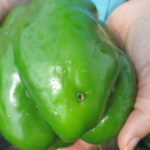It’s not uncommon for us to get calls from growers who are expressing concern about a particular insecticide product that is not working as well as the growers would like. Often, growers will suggest that Product X is no good or that the target insect has now developed resistance to that particular insecticide. Before we[Read More…]
Despite the wet start to the summer that we are experiencing, we have some growers reporting spider mites in field watermelons (Figure 1). This pest is typically associated with hot, dry weather and can be especially problematic in crops grown under protection, such as in high tunnels. Spider mites often move into a field from[Read More…]
Three species of seed and root maggots attack vegetables in Indiana. The seedcorn maggot feeds on seeds and seedlings of sweet corn, cucurbits, lima and snap beans, peas, and other crops. Cabbage maggots can cause serious damage to transplants of cabbage, broccoli, cauliflower, and Brussels sprouts and make the fleshy roots of radishes, turnips, and[Read More…]
One of the most problematic insect pests that organic vegetable growers have to deal with is the striped cucumber beetle. The insect feeds on all the cucurbit crops, but can be particularly devastating to muskmelons and cucumbers because those two crops are susceptible to bacterial wilt of cucurbits, which is caused by a bacterium carried[Read More…]
One way insects communicate with individuals of the same species is with pheromones. Pheromones are volatile chemicals released by an insect that usually can be detected only by individuals of the same species. There are a number of different types of pheromones, but the most common type is the sex pheromone. Usually the females will[Read More…]
Now is a good time to begin your plans for managing corn earworms (Figure 1) in your sweet corn. Below are several tips that will help you in this process: Make sure you have a corn earworm pheromone trap and earworm pheromones. See the article below for details. Consider planting Bt sweet corn, especially for[Read More…]
Populations of earworms, as evidenced by pheromone trap catches, have not gone to zero as the often due in July. Catches have been fairly low, but moths are still flying and presumably laying eggs. The good news is that in most areas, dent corn is silking, which attracts most of the moths away from our[Read More…]
There are three important caterpillar pests of crucifers in Indiana, the imported cabbageworm, the cabbage looper, and the diamondback moth. Each of these caterpillars will feed on leaves and heads. All are capable of producing serious damage to most crucifers. The adult imported cabbageworm is a common white butterfly with black spots on the forewing[Read More…]
European corn borers used to be a serious pest of peppers. The larvae would burrow into the fruit under the cap, making it difficult to cull out infested fruit. With the widespread adoption of Bt corn by agronomic farmers, populations of corn borers have been greatly reduced. However, it appears that in the last couple[Read More…]
When we first began working in high tunnels about 8 years ago, most of the popular literature said that the tunnels would provide protection from most insect pests, other than the usual greenhouse pests like aphids and mites. What we found very quickly is that that information was untrue. We found very high populations of[Read More…]







